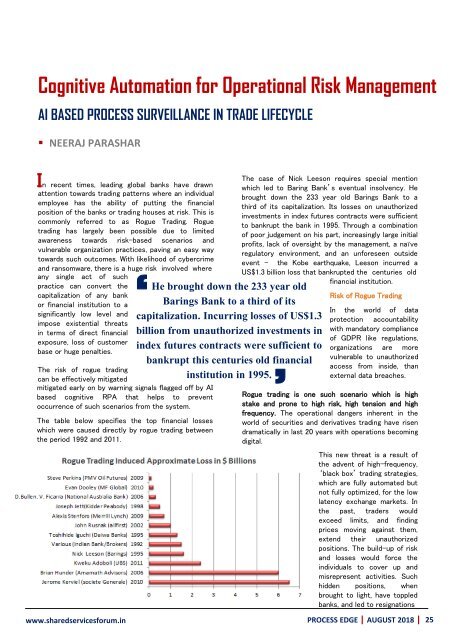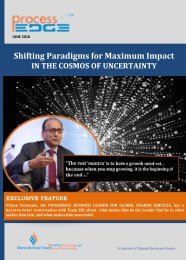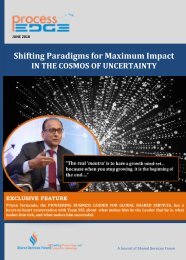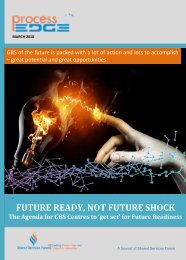SSF's Journal - Aug'18
You also want an ePaper? Increase the reach of your titles
YUMPU automatically turns print PDFs into web optimized ePapers that Google loves.
Cognitive Automation for Operational Risk Management<br />
AI BASED PROCESS SURVEILLANCE IN TRADE LIFECYCLE<br />
• NEERAJ PARASHAR<br />
In recent times, leading global banks have drawn<br />
attention towards trading patterns where an individual<br />
employee has the ability of putting the financial<br />
position of the banks or trading houses at risk. This is<br />
commonly referred to as Rogue Trading. Rogue<br />
trading has largely been possible due to limited<br />
awareness towards risk-based scenarios and<br />
vulnerable organization practices, paving an easy way<br />
towards such outcomes. With likelihood of cybercrime<br />
and ransomware, there is a huge risk involved where<br />
any single act of such<br />
‘<br />
practice can convert the<br />
capitalization of any bank<br />
or financial institution to a<br />
significantly low level and<br />
impose existential threats<br />
in terms of direct financial<br />
exposure, loss of customer<br />
base or huge penalties.<br />
The risk of rogue trading<br />
can be effectively mitigated<br />
mitigated early on by warning signals flagged off by AI<br />
based cognitive RPA that helps to prevent<br />
occurrence of such scenarios from the system.<br />
The table below specifies the top financial losses<br />
which were caused directly by rogue trading between<br />
the period 1992 and 2011.<br />
www.sharedservicesforum.in<br />
He brought down the 233 year old<br />
Barings Bank to a third of its<br />
capitalization. Incurring losses of US$1.3<br />
billion from unauthorized investments in<br />
index futures contracts were sufficient to<br />
bankrupt this centuries old financial<br />
institution in 1995.<br />
The case of Nick Leeson requires special mention<br />
which led to Baring Bank’s eventual insolvency. He<br />
brought down the 233 year old Barings Bank to a<br />
third of its capitalization. Its losses on unauthorized<br />
investments in index futures contracts were sufficient<br />
to bankrupt the bank in 1995. Through a combination<br />
of poor judgement on his part, increasingly large initial<br />
profits, lack of oversight by the management, a naïve<br />
regulatory environment, and an unforeseen outside<br />
event - the Kobe earthquake, Leeson incurred a<br />
US$1.3 billion loss that bankrupted the centuries old<br />
financial institution.<br />
Risk of Rogue Trading<br />
In the world of data<br />
protection accountability<br />
with mandatory compliance<br />
of GDPR like regulations,<br />
organizations are more<br />
vulnerable to unauthorized<br />
access from inside, than<br />
external data breaches.<br />
’<br />
Rogue trading is one such scenario which is high<br />
stake and prone to high risk, high tension and high<br />
frequency. The operational dangers inherent in the<br />
world of securities and derivatives trading have risen<br />
dramatically in last 20 years with operations becoming<br />
digital.<br />
This new threat is a result of<br />
the advent of high-frequency,<br />
‘black box’ trading strategies,<br />
which are fully automated but<br />
not fully optimized, for the low<br />
latency exchange markets. In<br />
the past, traders would<br />
exceed limits, and finding<br />
prices moving against them,<br />
extend their unauthorized<br />
positions. The build-up of risk<br />
and losses would force the<br />
individuals to cover up and<br />
misrepresent activities. Such<br />
hidden positions, when<br />
brought to light, have toppled<br />
banks, and led to resignations<br />
PROCESS EDGE | AUGUST 20<strong>18</strong> |<br />
25





